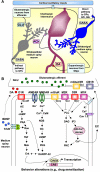Unwinding the molecular basis of interval and circadian timing
- PMID: 22022309
- PMCID: PMC3196210
- DOI: 10.3389/fnint.2011.00064
Unwinding the molecular basis of interval and circadian timing
Abstract
Neural timing mechanisms range from the millisecond to diurnal, and possibly annual, frequencies. Two of the main processes under study are the interval timer (seconds-to-minute range) and the circadian clock. The molecular basis of these two mechanisms is the subject of intense research, as well as their possible relationship. This article summarizes data from studies investigating a possible interaction between interval and circadian timing and reviews the molecular basis of both mechanisms, including the discussion of the contribution from studies of genetically modified animal models. While there is currently no common neurochemical substrate for timing mechanisms in the brain, circadian modulation of interval timing suggests an interaction of different frequencies in cerebral temporal processes.
Keywords: circadian system; cortico-striatal circuits; dopamine; glutamate; interval timing; serotonin; suprachiasmatic nuclei.
Figures


References
-
- Aguilar-Roblero R., Diaz-Muñoz M. (2010). Chronostatic adaptation in the liver to restricted feeding: the FEO as an emergent oscillator. Sleep Biol. Rhythms 8, 9–1710.1111/j.1479-8425.2009.00415.x - DOI
-
- Allen L. G., Gibbon J. (1991). Human bisection at the geometric mean. Learn. Motiv. 22, 39–5810.1016/0023-9690(91)90016-2 - DOI
LinkOut - more resources
Full Text Sources

